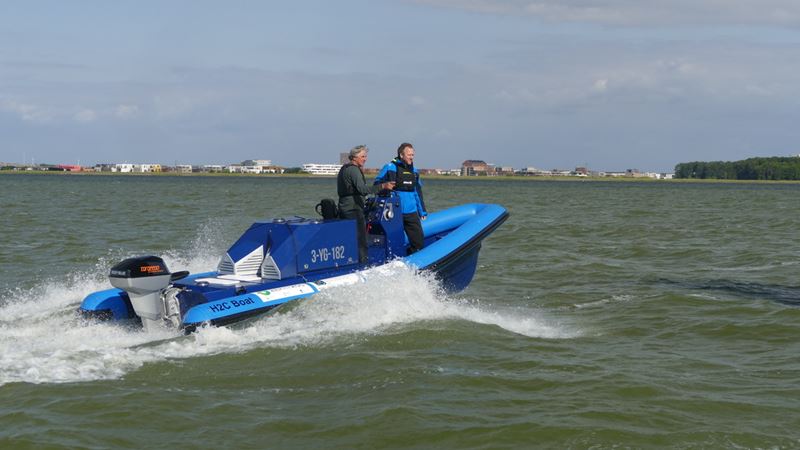H2 Marine Solutions founder and Olympic sailor, Cees van Bladel, speaks with Kim Hollamby about the background to his organisation’s developments with hydrogen as a performance extender for electric-powered high performance small craft.
What attracted you to working in the marine industry?
I started sailing in small dinghies from four years of age and ended up as an Olympic sailor in 1984 and 1988. If you are a leading sailor, you also have a coaching motorboat in attendance, so I am very familiar with powered craft. I also like rowing. Whether manpower, wind power, or a motor, I love getting out on the water.
My career started by working with the government and then a Nissan motor parts centre before breaking into sports and technology in Brainport Eindhoven. This is an innovative region designed to promote triple helix interaction between academia, industry and government. I set up a lot of field labs for sports, such as swimming, horse riding and gymnastics. Following the Beijing Olympics I also worked with the Netherlands Sailing Federation to create a highly optimised example of the 470 dinghy.
When the Sailing Federation moved to Scheveningen on the Netherlands coast, close to The Hague, I saw the opportunity to create a Sailing Innovation Centre. This provided the opportunity to work as a professional supporting the Dutch Olympic sailing team with innovations. I also founded my own business called Volans Rowing specialising in accessible rowing boats. More recently I added a startup to my activities, H2 Marine Solutions, with the objective to research and promote viable fast, small electrically powered motorboats with performance extended using hydrogen.
Tell us about your organisation
Olympic sailor and former Dutch sailing team head coach, Jaap Zielhuis, provided an inspiration for our hydrogen project. Following the Sailing World Championships in 2018 he spoke to me about the fact that sailing was supposed to be an environmentally clean sport and yet there were 400 coaching boats out on the water powered by internal combustion engines. It led to a discussion on the METSTRADE stage in 2018 with panellists including Volvo Ocean Race skipper Simeon Tienpont and the head of R&D at Damen Shipyards Group. This led directly to a collaborative offer from Torqeedo. We were also able to engage TU Delft students in research and found other partners to assist us.
We realised that pure electric power would not be sufficient to power championship level coaching boats, due to the dual demands of speed and endurance. We needed a range extender, which led to us researching a powertrain consisting of an electric motor, batteries, a fuel cell, hydrogen tank and a motor management system.
A proof-of-concept was launched in 2021 using a small boat with fuel cells from Intelligent Energy in the UK, who specialise in a variety of applications including fuel cells for drones. We used a small cylinder of hydrogen which could be changed easily. From there we decided to scale up to a full-size coaching boat.

We designed everything in the powertrain to keep weight to a minimum and were fortunate to partner with the port of Den Helder which provided a 60 per cent funding subsidy and a location for testing. They also have a big project to create solar panel-powered hydrogen electrolyser and filling station.
Our H2-C boat was on display during the Sailing World Championships in The Hague in August and is now in use by the Dutch Olympic Sailing Team. We still have some operational difficulties, including learning that hydrogen will leach through the thick walls of our 120-litre 700 bar carbon fibre tank!
The boat itself is not our business though – our focus is on developing a power train that can deliver high speed performance in commercial and leisure craft up to 10m. We want to create viable hydrogen-based solutions to extend the range and performance of electrically powered boats. For Olympic applications the system must be capable of delivering 38 knots and survive the 12G forces that can be experienced on high-speed seagoing coaching boats.
What interesting trends do you anticipate in the industry?
Foiling has been around a long time, but it is being reinvented to make boating more sustainable. The combination of electric propulsion and foils will be something to consider in the next few years, and we are of course seeing developments there already.
More consideration will need to be given by people regarding their sailing profile. They need to adjust what they do to match the performance characteristics of sustainable power trains just as electric car owners are doing when planning longer journeys.
We also need to incentivise people to change. In the case of sailing coaches, perhaps one way is to offer them more coaching boats if they choose zero emission options, or less if they want to stay with power that pollutes. At the high end we are now seeing the America’s Cup forcing the use of hydrogen powered chase boats. If elite sports people set an example it will help the wider market to adopt cleaner technologies.

What is the importance of METSTRADE to your business?
I visit to look at what’s new and what’s happening – it is good to walk around and open your eyes to what is being developed. It also helps me to network and connect – our partnership with Torqeedo happened as a direct result of participating in a discussion panel at the 2018 show.
Which METSTRADE areas and activities do you most look forward to?
I like the theatre and the discussions and gatherings of people there. A presentation on sustainability will often attract the kind of people I want to meet. If they ask a question about hydrogen, I know I want to talk with them. I also like the DAME Awards showcase. Other than that, my favourite thing is to walk around the show.
Read more from Humans of METSTRADE
Ana Čalić (Navela)Marieke de Boer (IMPACD Boats)
Rory Coase (Coase Design)













